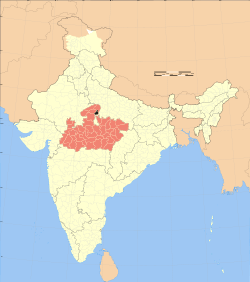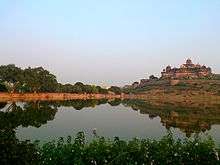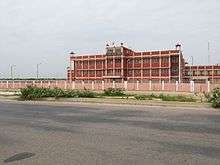Datia district
Datia District is in Gwalior Division in the Indian state of Madhya Pradesh. The town of Datia is its district headquarters.
Datia district | |
|---|---|
District of Madhya Pradesh | |
 Location of Datia district in Madhya Pradesh | |
| Country | India |
| State | Madhya Pradesh |
| Division | Gwalior division |
| Headquarters | Datia |
| Tehsils | Datia Seondha Bhander Indergarh and Badoni |
| Government | |
| • Lok Sabha constituencies | Bhind-Datia lok sabha constituency |
| • Vidhan Sabha constituencies | Datia Seondha and Bhander |
| Area | |
| • Total | 2,691 km2 (1,039 sq mi) |
| Population (2011) | |
| • Total | 786,754 |
| • Density | 290/km2 (760/sq mi) |
| • Urban | 181,976 |
| Demographics | |
| • Literacy | 72.63 per cent |
| • Sex ratio | 873 |
| Time zone | UTC+05:30 (IST) |
| Major highways | NH44 |
| Website | http://datia.nic.in |
History
It is an ancient town, mentioned in the Mahabharata. Sahadeva; one of the Pandava brothers had won this kingdom from King Dantavakra.Datia had formerly been a state in the bundelkhand region. The ruling family were Rajputs of the Bundela clan; they descended from a younger son of a former raja of Orchha. The chief rulers of Datia were Bhagwan Rao, Shubhkaran Rao, Dalpat Rao and Ramchandra and they had good relations with the Mughals. There is a fort palace at Datia, the architecture of which is chiefly Indo-Islamic which partly inspired the chief architect Edward Lutyens, while designing New Delhi. The state was administered as part of the Bundelkhand agency of Central India. It lay in the extreme north-west of Bundelkhand, near Gwalior, and was surrounded on all sides by other princely states of Central India, except on the east where it bordered upon the United Provinces.[1] It was second highest in the rank of all the Bundela states after Orchha, with a 15-gun salute, and its Maharajas bore the hereditary title of Second of the Princes of Bundelkhand. The land area of the state was 2130 mi² its population in 1901 was 173,759.[1]
Datia, together with the rest of the Bundelkhand agency, became part of the new state of Vindhya Pradesh in 1950. In 1956, Vindhya Pradesh state was merged with certain other areas to form the state of Madhya Pradesh within the Union of India.
Geography
In 2011, Datia had population of 786,754 of which male and female were 420,157 and 366,597 respectively The district has an area of 2,691 km2, and a population 627,818 (2001 census). The population of Datia District increased by 26% from 1981 to 1991, and by 22% from 1991 to 2001. The district has 445 villages and 4 towns, Datia, Seondha, Bhander and Indergarh. Each town is the headquarters of its tehsil.[2]
Datia is bounded by the Madhya Pradesh districts of Bhind to the north, Gwalior to the west, and Shivpuri to the south, and by Jhansi District of Uttar Pradesh state to the east. The district is part of Gwalior Division.[2]

Tourist Places
Datia also has some famous temples. Peetambra Peeth is one such temple which attracts a lot of pilgrims. Purana Mahal also known as Datia Mahal is visible from the railway line between Gwalior to Jhansi and was built to welcome King Jahangir after his coronation. The King never actually visited fearing he would have to reward the King of Datia for his help in getting the Mughal throne. Some of other tourist spot are Ratangarh Mata, Sonagiri-Temples, Shri Siddh Baba Mandir in Village Kurthara (Dilip Shrivastava is the sarpanch of kurthara), Beer Singh Deo Mahal, Unao-Balaji Sun Temple, Badi mata mandir, Bihari Ji Mandir, Govind Ji Mandir Rajgarh Palace & Museum and Samrat Ashok Silalekh in Gujarra.
Ratangarh Temple - Ratangarh temple is situated in Datia District. The Fort of Ratangarh is located near Seondha town, 66 km from Gwalior. It was built by the Baghel Ruler Ratan Singh Riyar. The fort is situated on the banks of the Sindh river. Raja Ratan Singh Riyar is a brave ruler of Bundelkhand.
Drainage
The Datia district comes under the Gangetic drainage system and is drained by the Sindh, the Pahuj, the Mahuar and the Betwa. The former two, however form the drainage system of the main body of the district. The rivers are almost seasonal and have heavy run off only during the peak period of July and August. During the dry season most of the streams become dry and water is available only in a few channels of the main stream.
Demographics
Population

According to the 2011 census Datia District has a population of 786,754[3] roughly equal to the nation of Comoros[4] or the US state of South Dakota.[5] This gives it a ranking of 487th in India (out of a total of 640).[3] The district has a population density of 271 inhabitants per square kilometre (700/sq mi)[3] with 76% living in rural regions and 24% living in urban areas. Its population growth rate over the decade 2001-2011 was 18.4%.[3] Datia has a sex ratio of 873 females for every 1000 males,[3] and a literacy rate of 72.63%.[3]
Languages
At the time of the 2011 Census of India, 99.27% of the population in the district spoke Hindi as their first language.[6]
Main spoken languages are Khadiboli and Bundeli with Dravidian spoken by at least 200 000 members of the Bharia tribe and this is written in the Devanagari script.[7] °
Religion
According to the census of 2011, 96% of residents follow Hinduism.
Culture
The main entertainment in Datia is music, dance and wrestling. However, due to it being a place of people with high spiritual values - religious festives hold a strong place. Datia's sindhi community also celebrate their festival of Jyoti Snaan annually during the months of July - August.
The economy of Datia district is primarily agrarian. However, in recent times there has been a surge in the commercial and industrial activities with the establishment of many new government and private offices City has industries like Agro Solvent Ltd., Govind Masale and many small and medium enterprises. Because of its historical significance tourism has become another vibrant industry in Datia town. Now Datia is also emerging as a medical tourism destination owing to its newly constructed world-class Medical College.
Education
According to the 2011 census, Datia has 750 primary schools, 500 middle schools and 250 high schools.
Datia has two ICSE affiliated schools namely Rani Laxmi Bai Puic School and Holy Cross Ashram School. The city also has plethora of CBSE affiliated schools such as Lord Krishna Public School and Little Flower School of Excellence. Some other important schools include Bright Morning Public School, primarily known for its quality education in pre-primary and primary sections. P. G. College and Rawatpura College are two important colleges in the city.
The newly established Government Medical College (Estd. 2018) has boosted the education sector of the area. It is located alongside NH-7 making it easily accessible.
Sport
Traditional games like Kho kho, Gulli Danda, Pittu Garam/Sitoliya, Kabbadi, Wrestling, Cricket, Chess, Judo, Table tennis, Badminton and Langdi are popular in Datia.
See also
References
-

- "Datia district". District Administration. Retrieved 2010-04-14.
- "District Census 2011". Census2011.co.in. 2011. Retrieved 2011-09-30.
- US Directorate of Intelligence. "Country Comparison:Population". Retrieved 2011-10-01.
Comoros 794,683 July 2011 est.
- "2010 Resident Population Data". U. S. Census Bureau. Archived from the original on 2013-10-19. Retrieved 2011-09-30.
South Dakota 814,180
- 2011 Census of India, Population By Mother Tongue
- M. Paul Lewis, ed. (2009). "Bharia: A language of India". Ethnologue: Languages of the World (16th ed.). Dallas, Texas: SIL International. Retrieved 2011-09-28.